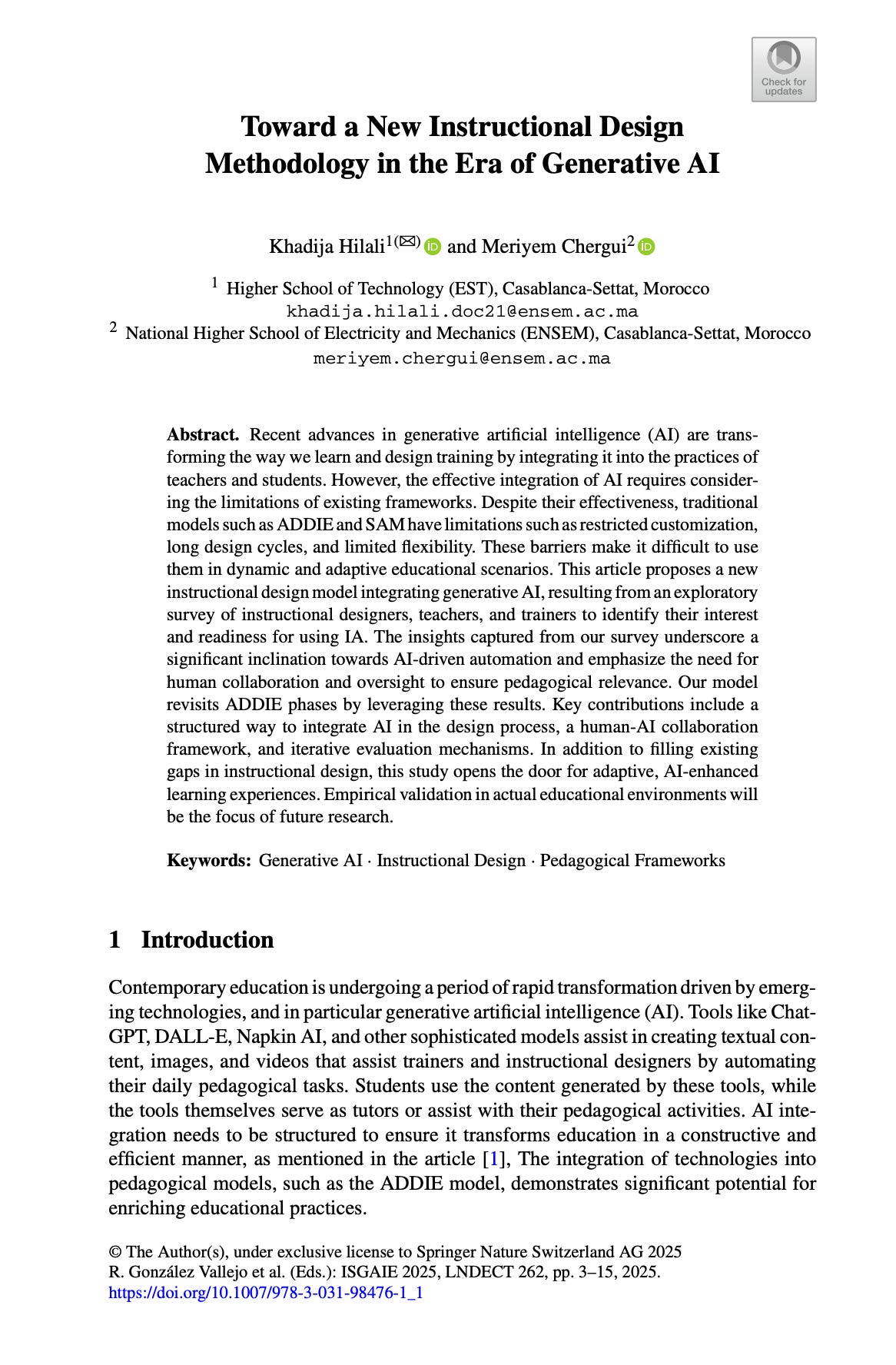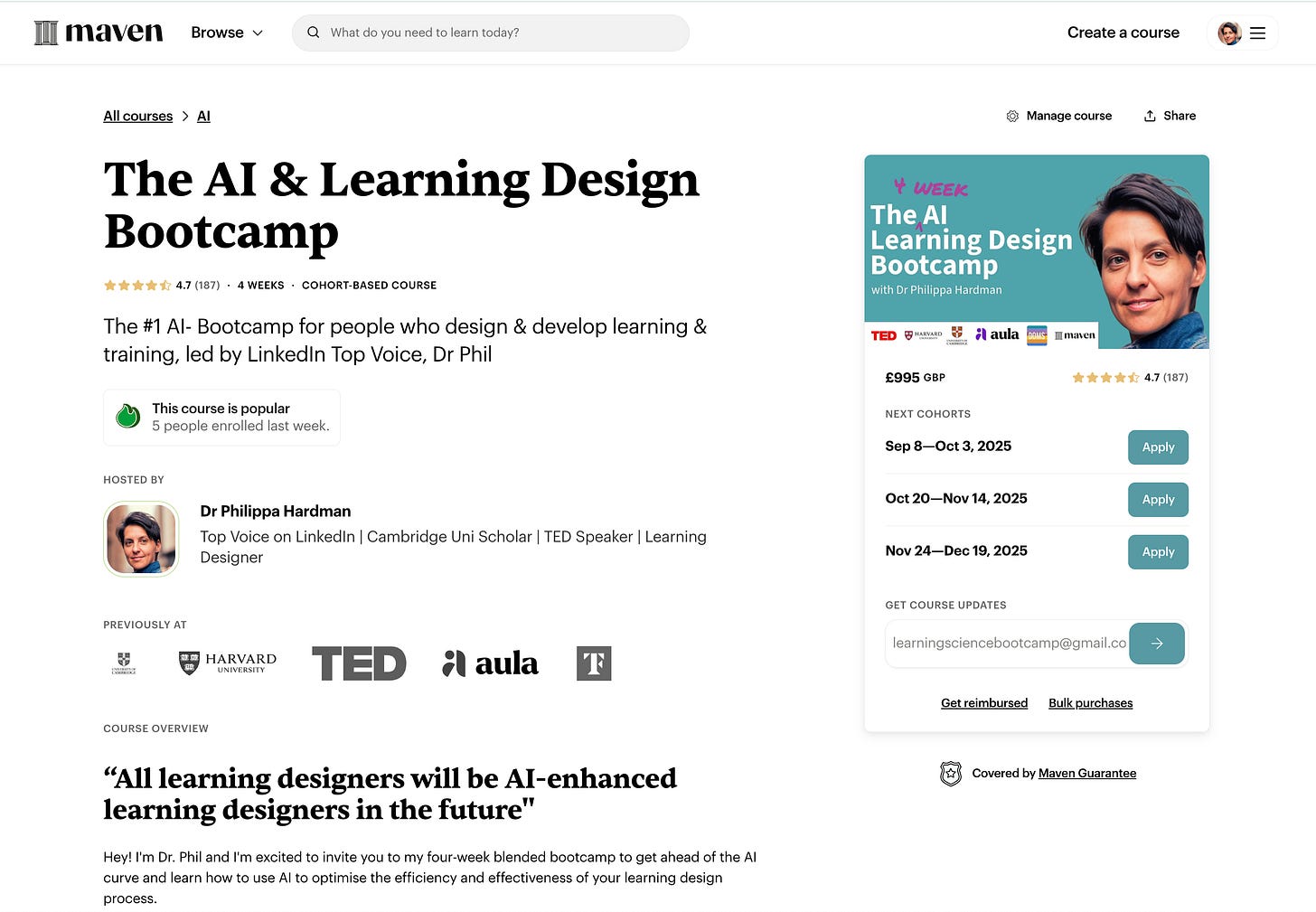Hey folks 👋
This week, as I prepared this month’s edition of my Learning Research Digest, I came across an interesting paper last month by a team of researchers in Morocco titled, "Toward a New Instructional Design Methodology in the Era of Generative AI".
In it, researchers propose that despite their effectiveness, traditional models like as ADDIE and SAM have limitations including restricted customisation, long design cycles and limited flexibility — barriers which have made it difficult to create dynamic, relevant and ultimately high-impact learning .

In the article, researchers puts forward the argument that Generative AI presents a long-awaited opportunity to innovate ADDIE and reimagine how we analyse, design, deliver & evaluate learning experiences.
In this week’s post,I'll break down the research, share compelling data on what your peers think about AI and explore what this might mean for the future of our roles.
Let’s go! 🚀
From ADDIE to ADGIE
According to the researchers who published the paper, ADGIE (Analysis-Design-Generation-Individualisation-Evaluation) isn't a replacement for ADDIE; it's an evolution of the model. Think of it as ADDIE with a super-powered AI assistant which enhances its speed and agility.
ADGIE was created to address what the researchers see to be a critical gap: instructional designers are already using tools like ChatGPT, but without a formal methodology to guide them.
ADGIE provides that framework, aiming to integrate AI responsibly and effectively. In effect, ADGIE is a blueprint to help Instructional Designers and educators more broadly to integrate generative AI into their day to day work in a way that optimises for value while mitigating risks.
So how does this new, AI-first model work in practice? Let's walk through the five phases of the framework to see how it defines the roles of AI and human designer:
Phase 1: Analysis
AI's Role: Uses Natural Language Processing capabilities to review analysis materials, e.g. SME & learner interviews, and generate detailed learner personas, knowledge and skills maps and other outputs.
Designer's Role: Acts as the strategist. You validate the personas, check them for nuance and ensure they align with the organisation's strategic goals.

Phase 2: Design
Designer's Role: You are the curator. You gather high-quality, relevant and accurate source content that will form the basis of the learning experience.
AI's Role: Takes your curated content, parses and structures it. It can draft multiple training plans, suggest different instructional approaches and build out pedagogical prototypes for you to review.
Phase 3: Generation (Replacing "Development")
AI's Role: This is where the efficiency gains come into play. The AI produces the first draft of learning assets—text, video scripts, diagrams, knowledge-check questions, and more—based on the approved design.
Designer's Role: You are the quality control. You review the AI's output for accuracy, tone, and pedagogical soundness. You then amend, refine, and create bespoke materials where the AI falls short.
Phase 4: Individualisation (Replacing "Implementation")
AI's Role: The AI analyses learner data in real-time. If a learner is struggling with a text-based module, it can instantly generate a summary video. If a learner shows high interest in a topic, it can generate deeper-dive materials.
Designer's Role: You are the overseer. You monitor learners’ performance and the quality of the the AI's adaptations, ensuring they are equitable, relevant and genuinely helping learners achieve their objectives.
Phase 5: Evaluation (Now Transversal & Continuous)
Combined Role: Unlike in traditional ADDIE, evaluation isn't just the last step — it’s a continuous, iterative loop. Learner performance, both within and outside of the learning experience, is constantly monitored and learning experiences are adapted to drive the achievement of outcomes.
The role of the designer is track and monitor performance and adaptation data, and ensure that AI prompts and methods are optimised for the best possible outcomes for all learners.
How to Prepare for a New Reality: 3 Predicted Shifts in the Instructional Design Role
Based on the data, there are three concrete shifts in the ID role. Here’s my take on what they are, and how you can start preparing today:
1. From Content Creator to Curator & Validator
The Evidence: 94% of professionals want AI to generate materials, but 91% insist on their role in validating that content.
The Shift: Your value is moving from writing the first draft to ensuring the final draft is perfect. You are the expert who curates high-quality source material for the AI and critically validates its output.
How to Prepare:
Hone Curation Skills: Practice identifying and vetting source materials for accuracy, relevance, and bias.
Develop a Validation Framework: Create a personal checklist for reviewing AI content that includes instructional soundness, tone, inclusivity, and potential biases.
2. From Project Manager to Pedagogical Expert
The Evidence: While 83% are open to AI suggesting a course plan, only 49% felt "very ready" to let AI select the core teaching methods.
The Shift: The tactical, organisational parts of design are being automated, elevating your role to focus on the "why" behind the learning. You define the core instructional strategy that the AI will then execute.
How to Prepare:
Deepen Pedagogical Knowledge: Revisit learning science and instructional theories. Your expertise in how people learn is your most valuable asset.
Learn Prompt Engineering: Practice writing detailed prompts that translate your pedagogical strategy into clear instructions for the AI.
3. From Developer to Systems Builder
The Evidence: The ADGIE model tasks the designer with overseeing AI-driven adaptations to "ensure equity and relevance."
The Shift: As learning becomes more automated, your responsibility expands to include the ethical implications of the system. You are the human check on the algorithm.
How to Prepare:
Build AI Ethics Literacy: Start learning about algorithmic bias and data privacy to spot and correct issues.
Focus on Data Analysis Skills: Learn the basics of learning analytics to understand if the AI-driven pathways are leading to successful outcomes for all learners.
Conclusion: Does ADGIE Provide a Window into the Future of Instructional Design?
So, what does all of this mean in practice — if anything?
It’s important to ask whether one academic paper can tell us anything substantive about the future of Instructional Design. While this is a single paper and while ADGIE is a model proposed by just one research team, it pulls together a number of trends that are already underway across the learning and development industry.
The researchers behind ADGIE didn't just theorise — they surveyed 90 education professionals (including 43% instructional designers) to gauge their readiness for AI integration. Here’s the TLDR:
There is a huge appetite for AI assistance in time-consuming tasks:
94% want AI to suggest training materials.
94% want AI to propose interactive exercises and activities.
83% are open to AI suggesting entire course or training plans.
But ,there’s a very strong view that humans must remain in control of core pedagogy.
An overwhelming 91% insist on their role in validating the quality and relevance of AI-generated content.
Only 49% felt "very ready" to let AI participate in selecting teaching methods, showing significant caution about handing over fundamental pedagogical decisions.
A number of reports, including one that I produced with Syntehsia in late 2024, show a massive uptake in the use of AI among Instructional Designers since. My view here is that, while “ADGIE" specifically is a new concept, the processes and behaviours that it describes are an articulation of a change that has been underway over the last two years or so.
Overall, I think that this paper and the concept of ADGIE captures a significant appetite within the profession for AI-enhancement of outdated and suboptimal processes. It also provide a much-needed QA of exactly how we are using AI in Instructional Design. It also provides a vocabulary and structure for an evolution that is already well underway.
In my mind, the ADGIE model provides a practical v1 roadmap for the changing nature of our field. The supporting data confirms what many of us feel: we are ready for a change, but one that respects our expertise and keeps us - the humans - in the driver's seat.
I recommend that you take a look at the paper for yourself, and take some time to think about if and how your day to day role may change in the near future as a result of AI.
Happy innovating!
Phil 👋
PS: Want to hone your pedagogical expertise and explore the impact of AI on your day to day work and overall process with me and a group of people like you? Apply for a place on my AI & Learning Design Bootcamp.


